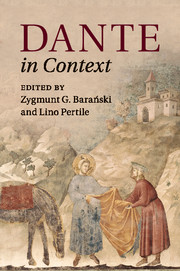Book contents
- Frontmatter
- Dedication
- Contents
- List of illustrations
- List of maps
- Notes on contributors
- Chronology
- Abbreviations and note on translations
- Introduction
- Part I Politics and society
- 1 Empire, Italy, and Florence
- 2 Economy
- 3 Law
- 4 Justice
- 5 Men and women
- 6 Church and orthodoxy
- 7 Heresy and dissidence
- 8 Daily life
- Part II Intellectual traditions
- Part III Linguistic and literary cultures
- Part IV Visual and performative culture
- Part V Dante: life, works, and reception
- Further reading
- Index
6 - Church and orthodoxy
from Part I - Politics and society
Published online by Cambridge University Press: 05 October 2015
- Frontmatter
- Dedication
- Contents
- List of illustrations
- List of maps
- Notes on contributors
- Chronology
- Abbreviations and note on translations
- Introduction
- Part I Politics and society
- 1 Empire, Italy, and Florence
- 2 Economy
- 3 Law
- 4 Justice
- 5 Men and women
- 6 Church and orthodoxy
- 7 Heresy and dissidence
- 8 Daily life
- Part II Intellectual traditions
- Part III Linguistic and literary cultures
- Part IV Visual and performative culture
- Part V Dante: life, works, and reception
- Further reading
- Index
Summary
Nestled within the densely packed warren of narrow medieval streets north of the present-day Piazza della Signoria are the Piazza San Martino and the tiny Church of San Martino del Vescovo. Originally founded in the tenth century, the oratorio of San Martino is named after the Compagnia dei Buonomini, but the church still seems to be known as San Martino del Vescovo. It is the fifteenth-century incarnation of the church that was once Dante's neighbourhood parish church. During Dante's lifetime the local priest of this small, simple church probably lived and worked precisely as his predecessors had done for two centuries: he administered the sacraments, heard confessions, married his parishioners, presided over their funeral masses, witnessed important agreements involving locals, and probably recited the divine office in private as often as possible. In the course of Dante's lifetime in Florence – from his boyhood in the 1260s and 1270s to his exile in 1302 – the routines and traditions of this neighbourhood church probably changed very little. However, this was not the case with regard to the Florentine Church as a whole, particularly its institutions. Indeed, they were undergoing significant and far-reaching transformations.
From the middle of the thirteenth to the beginning of the fourteenth century, Florence emerged as the dominant economic, political, and military power in Tuscany. Its new hegemony was dramatic, since for centuries Dante's native city had been overshadowed by its neighbours, Lucca and Pisa, and challenged by its rival, Siena. In the spring of 1267 the standard-bearer of the pro-papal, Angevin alliance, Charles of Anjou (1226–85), marched into the city with his army and brought a formal end to seven years of Ghibelline rule. Thenceforth, for the next seventy years Florence became the principal Tuscan ally of the papacy, the house of Anjou, and the kingdom of Naples. In 1282 the most prosperous, non-noble men in the guilds of the city (the popolo) consolidated their political control through the institution of the magistracy of the priorate, and by 1295 they had deepened their power and influence through the passage of the Ordinances of Justice. At the same time, Florentine urban population was growing exponentially, fuelled by rural immigration, and by 1300 it had exceeded 100,000. The rural population of its territory (contado) was around 245,000.
- Type
- Chapter
- Information
- Dante in Context , pp. 83 - 105Publisher: Cambridge University PressPrint publication year: 2015



